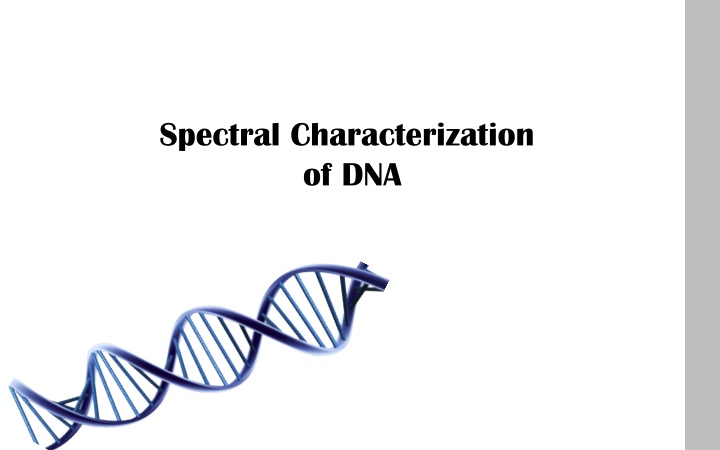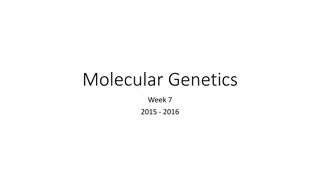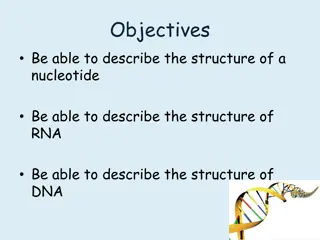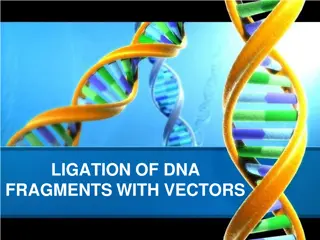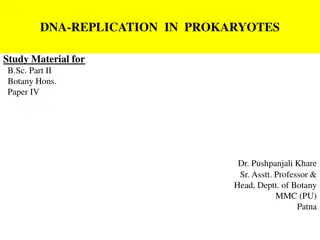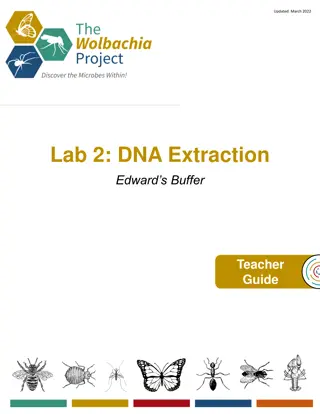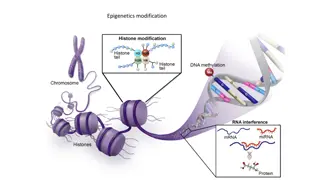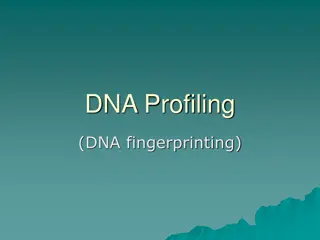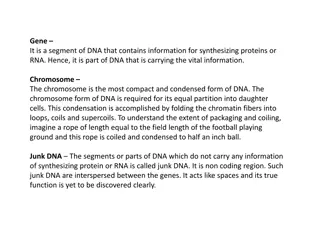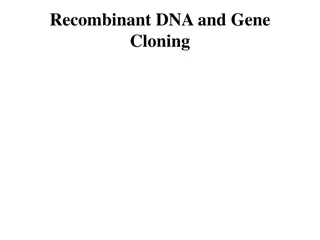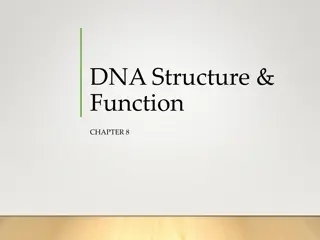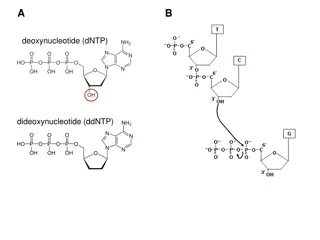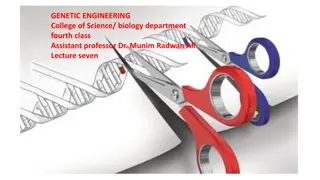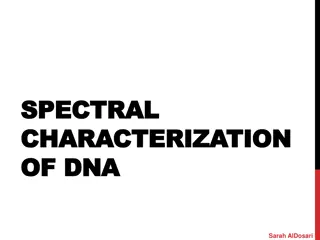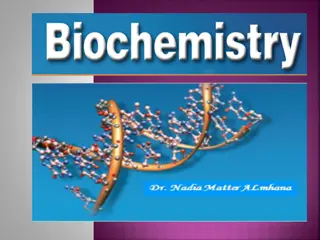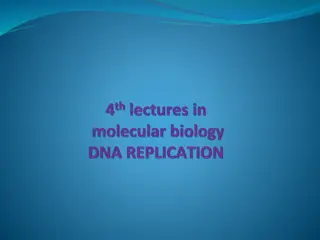The Intriguing Structure and Functions of DNA
DNA, or Deoxyribonucleic Acid, is a fundamental molecule in living organisms, characterized by its double helical structure consisting of two antiparallel polynucleotide chains. Each strand is composed of nucleotide monomers, comprising deoxyribose sugar, phosphate group, and nitrogenous bases (purines and pyrimidines). The hydrogen bonds between complementary bases facilitate the stability of the double helix. DNA's optical density is highest at 260nm due to the absorbance of its nitrogenous bases. Denaturation of DNA disrupts its structure through various means like strong acids, heat, or UV light.
Download Presentation

Please find below an Image/Link to download the presentation.
The content on the website is provided AS IS for your information and personal use only. It may not be sold, licensed, or shared on other websites without obtaining consent from the author.If you encounter any issues during the download, it is possible that the publisher has removed the file from their server.
You are allowed to download the files provided on this website for personal or commercial use, subject to the condition that they are used lawfully. All files are the property of their respective owners.
The content on the website is provided AS IS for your information and personal use only. It may not be sold, licensed, or shared on other websites without obtaining consent from the author.
E N D
Presentation Transcript
Spectral Characterization of DNA http://www.godandscience.org/images/dna-helix.gif
- - DNA [Deoxyribonucleic acid] : DNA [Deoxyribonucleic acid] : -DNA is made of two polynucleotide chains which run in opposite direction. [antiparallel antiparallel] -DNA has a double helical structure double helical structure. Each polynucleotide chain of DNA consists of monomer units of nucleotides nucleotides. -A monomer unit, [each nucleotide] consists of 3 main components that are: 1-sugar, 2-phosphate, 3-nitrogenous base.
DNA Structure: DNA Structure: 1. 1. Deoxyribose Deoxyribose sugar: Is a monosaccharide 5-Carbon Sugar, Its name indicates that it is a deoxy sugar, meaning that [ it is derived from the sugar ribose by loss of an oxygen atom ]. sugar: 2 2.. Phosphate Group: Phosphate Group: The sugars are joined fifth carbon atoms of adjacent sugar rings. joined together by phosphate groups that form phosphodiester bonds between the third and 3. 3. Nitrogenous bases: Nitrogenous bases: is a nitrogen-containing organic molecule having the chemical properties of a base. They are classified as the derivatives of two parent compounds, 1. Purine. [ Adenine Adenine, Guanine Guanine ] 2. Pyrimidine. [ Cytosine Cytosine, Thymine Thymine ]
4. 4. Hydrogen bond: Hydrogen bond: The H H- -bonds The base in the first strand forms an H-bond only with a complementary strand. Those two bases form a base base- -pair pair (H-bond interaction that keeps strands together and form double helical structure). bonds form between base pairs of the antiparallel strands. complementary base in the second Sugars and phosphates are located outside of the double helical structure.
Optical density of DNA: Optical density of DNA: -Nucleic acid have maximum absorbance at 260 (A, G, C and T) of DNA. 260nm nm, It absorbs at this wavelength because of the nitrogenous bases In a spectrophotometer, a sample is exposed to ultraviolet light at 260 light that passes through the sample. 260 nm nm, and a photo-detector measures the Absorbance Weave length [nm]
Denaturation of DNA: Denaturation of DNA: Denaturation is a process by which nucleic acids, such as DNA, lose their three-dimensional structures and consequently their functions. Many different substances or environmental conditions can denature nucleic acids, such as -strong acids, organic solvent -heating -Exposure to Radiation/ UV light
Hyperchromicity Hyperchromicity :: The increase of absorbance increase of absorbance (optical density) of DNA occurs when the DNA duplex is denatured. - Due to denaturation of DNA the strands separate and able to absorb more light at and able to absorb more light at 260 separate (become single strand) and bases become exposed to the surface nm (non-stacked bases). This action is calling the hyperchromic effect. bases become exposed to the surface 260 nm ( Note: Note: The opposite, a decrease of absorbance is called hypochromicity hypochromicity
The effect of temperature on the absorbance of DNA: The effect of temperature on the absorbance of DNA: Objectives: Objectives: 1- To establish the effect of temperature on the absorbance of DNA or [hyperchromic effect]. 2- To determine the optimum wave length for DNA. Principle: Principle: When DNA in solution is heated above its melting temperature (usually more than 80 C), the double-stranded DNA unwinds unwinds to form single-stranded DNA. The bases become unstacked and can thus absorb more light absorb more light. Note: Note: In their native state, the bases of DNA absorb light in the 260-nm wavelength region. When the bases become unstacked, the wavelength of maximum absorbance does not change the wavelength of maximum absorbance does not change, but the amount absorbed increases by 30-40%. - a double strand DNA dissociating to single strands produces a sharp cooperative transition.
Method: Method: 1- Read the absorbance of the DNA solution at the following wave lengths: (240, 245, 250, 255, 260, 265, 270, 275, 280) using distilled water as a blank. 2- Then put the DNA solution in boiling water bath for 15 min Immediately measure the absorbance at the following wave lengths: (240, 245, 250, 255, 260, 265, 270, 275, 280)
Results: Results: Plot The absorption spectra of the native DNA solution and the denatured DNA against wave lengths. write your comment regarding the two graphs in the discussion. And determine the optimum wavelengh. Wave length (nm) Absorbance of isolated DNA Absorbance of heated DNA 240 245 250 255 260 265 270 275 280
Effect of temperature on the absorbance of DNA [hyperchromic ] 1.6 1.4 1.2 1 Absorbance 0.8 isolated DNA 0.6 Heated DNA 0.4 0.2 0 235 240 245 250 255 260 265 270 275 280 285 290 Wavelenghth (nm)
Questions: Questions: Can you quantify DNA using photometer?
